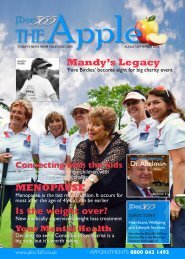You also want an ePaper? Increase the reach of your titles
YUMPU automatically turns print PDFs into web optimized ePapers that Google loves.
How do you feel?<br />
20% of breast cancers can be found by self examination<br />
One in eight women will contract breast cancer. It is the commonest<br />
cancer in the UK with 80% of cases recorded in women aged over 50.<br />
by Dr. Sylvia Abramov<br />
85% of patients survive breast cancer for 5 years or<br />
more so early detection is essential. Some risk factors<br />
are inherited, a history of breast cancer or other breast<br />
conditions, an early start of periods or late menopause<br />
also increases the likelihood of breast cancer.<br />
Other factors include the use of hormones in the<br />
contraceptive pill, a late first pregnancy (over 30 years<br />
old), obesity, smoking, excessive drinking and postmenopausal<br />
HRT. No scientific evidence supports the<br />
theory that antiperspirant, tight bras, termination of<br />
pregnancy or breast implants impact on risk. However,<br />
prolonged breastfeeding seems to be protective, as<br />
well as exercise.<br />
Brisk walking for just two hours a<br />
week reduces the risk of breast<br />
cancer by 18%<br />
About 20% of breast cancers are found by physical<br />
examination rather than mammography. Look in the<br />
mirror for uneven breast size or shape, nipple changes<br />
or discharge, or a rash. Check with arms raised too.<br />
Feel your breasts while lying down. Use the pulp of<br />
your fingers to check the opposite breast in small<br />
circular movements. Start from the nipple and move in<br />
larger circles, covering the whole breast to the armpit.<br />
Breasts can feel lumpy, but you are looking for a lump<br />
that feels different from the rest of the glandular tissue,<br />
or a palpable lymph node in the armpit. Regular selfexamination<br />
helps to identify changes early. Not all<br />
lumps are cancer but if in doubt, consult your Doctor.<br />
If a lump or nipple discharge is found, or as a regular<br />
screening tool for women between 50 and 70, a<br />
mammogram may be carried out. MRI scans can be<br />
used for screening high risk women too, or to examine<br />
a suspicious area. If an abnormality is detected, a biopsy<br />
is the only way to tell if cancer really is present.<br />
JDoc365 provides breast screening, advice and, where<br />
appropriate, referral to consultant breast surgeons. Call<br />
0800 043 1492 for an appointment today.<br />
6 JDOC365 APPLE MAGAZINE





